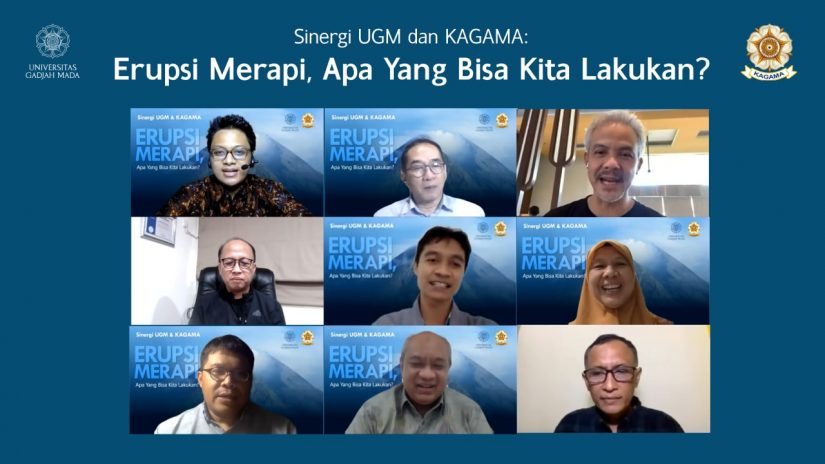
The webinar synergizing UGM and KAGAM titled “Merapi Eruption, What Can We Do?” was held on Sunday (29/11) through the Zoom Meeting Room. This event aimed to discuss the current condition of the volcano, especially the potential for eruptions and potential hazards. It also discussed the role of UGM alumni to respond the disaster and its mitigation.
Attending the event were Anwar Sanusi, Ph.D., Vice Dean 2 of PP KAGAMA, and Prof. Dr. Paripurna, S.H., M.Hum., LL.M., Vice-Rector for Cooperation and Alumni Affairs. They delivered their welcoming speech. As is well known, the eruption of Merapi is a natural phenomenon that occurs in a 4-year cycle. Therefore, UGM and KAGAMA continued to look for its mitigation management.
“UGM and KAGAMA are great. Every time a natural disaster occurs, KAGAMA and UGM always respond to it as soon as possible and be in the location as early as possible. Therefore, they could immediately work hand in hand with community and local government.” said Prof. Panut in his welcoming speech.
Anwar Sanusi, Ph.D. stated that Merapi eruption was a natural event that must be responded quickly and precisely—for example, disaster preparedness, tropical diseases, geological-related symptoms, and disaster engineering. Anwar said that UGM always responded to all community issues. Thus, this webinar was also expected to help develop existing potentials.
The keynote speaker, Ganjar Pranowo, who is also the General Chairman of PP KAGAMA and the Governor of Central Java, expected that this event could be used to convey thoughts, ideas, or ideas in response to Merapi eruption. Through the synergy of UGM and KAGAMA, there is a need for improvements related to disaster mitigation from social aspects, such as increasing awareness for the community so that they understand and are ready to face disasters.
Also attending the webinar as speakers were Dr. Hanik Humaida, M.Sc., Lilik Kurniawan, ST, M.Si., Dr. Ir. Agung Harijoko, S.T., M.Eng., IPM., and dr. Riris Andono Ahmad, MPH, Ph.D. Dr. Danang Sri Hadmoko, S.Si., M.Sc., Director of Partnerships, Alumni and Global Innitiatives, acted as the moderator.
The first presentation was delivered by Dr. Hanik Humaida, who said many the preparedness should be carried out even though Merapi had much equipment. Coordination and dissemination with the community and the government and the hazard assessment should be continuously updated. She also said that the community should always follow the local government’s instructions and not be influenced by hoax news.
Next presentation was delivered by Dr. Ir. Agung Harijoko, S.T., M.Eng., IPM., Head of the UGM Centre for Natural Disaster Studies, and one of the UGM geologists. He explained that many sources out there could be adapted and applied to reduce the risk of Merapi eruption. Besides, we should learn mitigation, such as understanding the risks and the development planning by measuring the disaster effect. Studying the past Merapi eruption would be helpful to map the vulnerable area.
Lilik Kurniawan, ST, M.Sc., Deputy for Prevention and Preparedness BNPB (The National Agency for Disaster Countermeasure), pointed out the threat of disasters in 2020; Merapi eruption, Covid-19, and cold lava floods due to the La Nina phenomenon. The strategies for handling the Merapi eruption included before the eruption, during the eruption, and after the eruption. Currently, people work on dealing with the pre-eruption phase, including prevention and mitigation. Mitigation is categorized into structural mitigation related to community activities and non-structural mitigation, which focused on strengthening the capacity. Lilik hoped that UGM and KAGAMA could play a role in helping the community around Merapi.
The last speaker was dr. Riris Andono Ahmad, MPH, Ph.D., Director of Tropical Health UGM, famously known as dr Doni. He said that we must apply the health protocol even during disaster management to prevent the transmission of covid-19. Besides, he said that SOP to regulate evacuation management is needed considering that refugee camps are very prone to spreading viruses. There will be high mobility of volunteers who go in and out of disaster areas. dr. Doni hoped that the number of public isolation and hospital’s isolation facilities would be increased to prevent the transmission in disaster-prone points.
The synergy between UGM and KAGAMA was a form of UGM’s concern for the community by looking for strategies for prevention, disaster mitigation, and increasing social awareness to reduce disaster risk.
[Alumni Relations / Articles: Winona, Photo: Dave]
